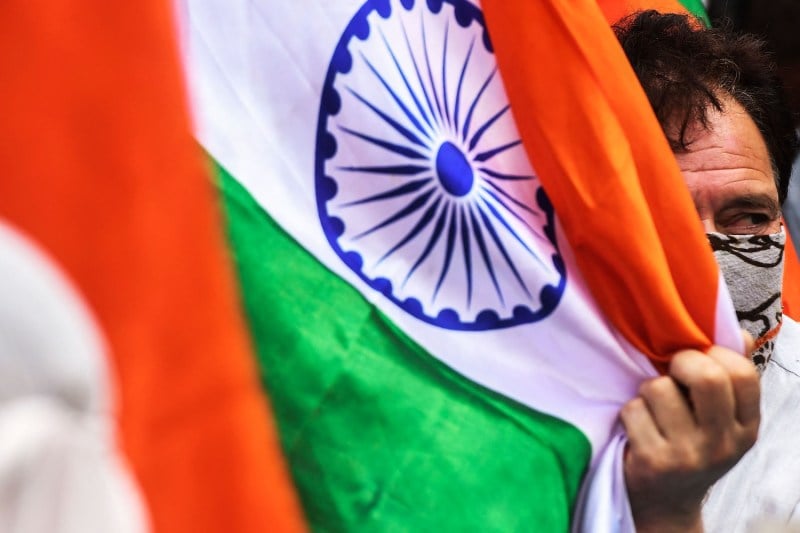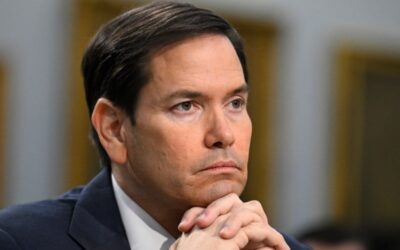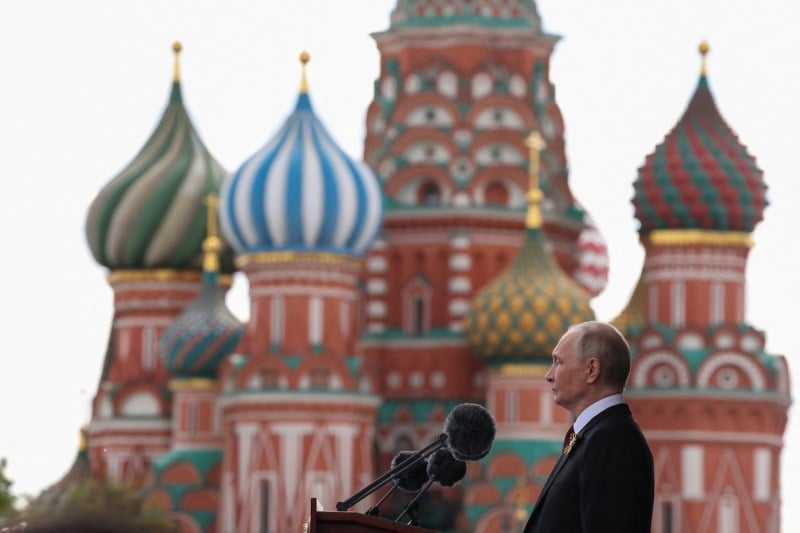Can India Finally Grab Its Trade Moment?

Can India Finally Grab Its Trade Moment?
Amid a renewed debate on protectionism, the world’s most populous country remains a tariff outlier.
A supporter of Bharatiya Janata Party (BJP) holds India’s national flag in Srinagar on July 25, 2022. Tauseef Mustafa/AFP via Getty Images
On April 2, President Donald Trump announced sweeping and unprecedented tariffs on U.S. trading partners, intensifying global economic uncertainty and triggering a sharp stock market decline in the United States and elsewhere. At the same time, China continues to face headwinds from the global “China+1” strategy, as countries seek to diversify their supply chains and reduce dependence on Chinese manufacturing—a concern that has grown with the escalation of U.S.-China trade tensions. India should seize this moment to set a bold new ambition: to become a more reliable trading partner to the world than either China or the United States. Its size and long-term potential lend credibility to such a vision. Realizing it, though, will require a fundamental rethinking and overhaul of India’s trade policy approach.
Trump has frequently called out India as the world’s “tariff king,” and this is not far from the truth. India is a tariff outlier. If the renewed debate on protectionism helps India understand that its trade policies are self-defeating, Trump might end up doing India, and the world, a huge favor.
On April 2, President Donald Trump announced sweeping and unprecedented tariffs on U.S. trading partners, intensifying global economic uncertainty and triggering a sharp stock market decline in the United States and elsewhere. At the same time, China continues to face headwinds from the global “China+1” strategy, as countries seek to diversify their supply chains and reduce dependence on Chinese manufacturing—a concern that has grown with the escalation of U.S.-China trade tensions. India should seize this moment to set a bold new ambition: to become a more reliable trading partner to the world than either China or the United States. Its size and long-term potential lend credibility to such a vision. Realizing it, though, will require a fundamental rethinking and overhaul of India’s trade policy approach.
Trump has frequently called out India as the world’s “tariff king,” and this is not far from the truth. India is a tariff outlier. If the renewed debate on protectionism helps India understand that its trade policies are self-defeating, Trump might end up doing India, and the world, a huge favor.
Trump’s tariffs have been labeled by economist Paul Krugman as the “biggest trade shock in history.” Including all tariff changes announced as of mid-May, average effective tariffs in the United States—the world’s largest importing country—are calculated at 17.8 percent (assuming the share of countries in U.S. imports remains the same) or 16.4 percent (after assuming shifts in demand to lower tariff countries). The latter is the highest rate since 1937.
These actions are roiling the world economy, leading to retaliation by some partners—especially China—and pushing the rest of the world to find other sources of demand. This is, in turn, accelerating negotiations on trade partnerships that do not involve the United States. Most countries will also intensify efforts to preserve and reform the rules-based international trading system. Irrespective of how the future tariff landscape evolves, the “uncertainty tax” on business has dramatically increased since November 2024: A global index of economic uncertainty was already higher in January 2025 than at any time since 1997 and would certainly have increased further since then (and the International Monetary Fund says trade policy uncertainty is “off the charts”).
While demand-side diversification strategies away from the United States are a recent phenomenon, efforts to diversify supply chains away from China have existed since the 2000s, gaining significant traction during the first round of the U.S.-China trade wars and during the COVID-19 pandemic. China has not helped its case by weaponizing trade to score political points: Examples include restricting rare-earth exports to Japan owing to contestation about the Senkaku Islands (which China calls the Diaoyu) and cutting demand from Australia after it called for an investigation into the origins of COVID-19. China’s ongoing trade war, which has intensified further after it announced retaliatory tariffs against the U.S. levies, and a more general export control on rare earths also make countries wary of getting involved in the crossfire. Finally, China’s opaque export subsidies have made it a frequent target of anti-dumping duties and prompted efforts to find other supply sources.
It seems the stage is set for the world’s most populous country to take on a more prominent role in world trade. But India is being held back by a diffident approach to trade. Between 2015 and 2022, India’s simple average tariffs rose from 13.4 to 18.1 percent. Despite declining to 17 percent in 2023, its tariffs rates are significantly higher than those of countries with which it is competing for a share of the China+1 pie: Vietnam’s average tariff is 9.4 percent, and other Southeast Asian competitors fall in the 8-10 percent range. India’s elevated tariffs—particularly high on many final goods such as automobiles and apparel—raise costs for exporters and consumers and encourage firms to sell into the protected domestic market. High tariffs have also rendered India vulnerable to World Trade Organization complaints by partners.
Moreover, after 2022, India has seen a spurt in quality control orders, or QCOs: quality standards that must be met by domestic and foreign producers. These QCOs, now covering more than 100 sectors, are often opaque, incentivize lobbying, and lead to significant delays in import clearances; economists call these “nontariff barriers.”
This rise in protection harks back to India’s past. After independence in 1947, India’s leaders opted for import substitution industrialization, a strategy based on high import protection—invoking the infant industry argument—and a leading role for the state in the “commanding heights” of the economy, such as capital goods and other core sectors such as steel, chemicals, and trucks. This economic nationalism was a reaction to the British Empire’s open economy approach and was nurtured for more than four decades by the Indian National Congress party, whose leaders led the independence struggle.
But the recent rise in import barriers—aimed at promoting Prime Minister Narendra Modi’s “Make in India” initiative and reviving a manufacturing sector in decline relative to the rest of the economy—ignores the lessons of India’s post-1991 economic success, when a macroeconomic crisis gave India’s policymakers the political space to liberalize onerous trade, industrial, financial, and foreign exchange policies. Average tariffs were steadily reduced from 81 percent in 1990 to 29 percent in 1997 and 9 percent by 2010. The impact on trade was conspicuous: Goods trade rose from 11 percent of GDP in 1988 to a peak of 43 percent in 2012.
In the last decade, as Indian tariffs rose, Vietnam—a country with just 7 percent of India’s population—has become a serious competitor. It already exports more manufactured goods than its much larger Asian counterpart. Both countries import significant quantities of chemicals as production inputs. But Vietnam’s average import duty on chemicals is just 3 percent, compared with 10.3 percent in India. Moreover, more than 50 percent of chemicals enter Vietnam duty-free, whereas in India, this figure is a mere 0.2 percent. This pattern holds across other key inputs, meaning that Indian firms consistently pay higher costs for raw materials than Vietnamese competitors, making it significantly harder for them to compete in global markets.
India’s tariff regime has also been a major roadblock in its efforts to secure comprehensive free trade agreements, or FTAs, with key trading partners. For example, its negotiations with the European Union, which began in 2007, have not yet reached a conclusion, largely due to disagreements over tariff reductions. While India has signed trade agreements with Australia and the United Arab Emirates, these are “early harvest” deals that fall short of the commitments found in comprehensive FTAs. The failure to secure comprehensive trade agreements has significant implications for India’s export growth. Vietnam, by contrast, has signed FTAs with both the EU and U.K., enabling Vietnamese firms to enjoy important preference margins over their Indian counterparts—in garments, for instance, the duty differential could be as high as 12 percent.
High tariffs and other trade barriers also reduce domestic market competition and create incentives for protectionism to persist. Low tariffs can discipline rent-seeking behavior by large firms and are important in a context where industrial concentration is rising: The share of the largest five business groups in India’s nonfinancial sector rose from 10 percent in 1991 to nearly 18 percent in 2021. The discipline imposed by low tariffs was missing in India, where tariffs rose between 2015 and 2022.
Trump announced a 26 percent tariff rate on India as part of his April 2 announcements, even as the two sides are pursuing an early closure to a bilateral trade agreement (BTA) by later this year. India is hoping, especially with the 90-day pause, that a concluded BTA will help it sidestep the punitive tariffs imposed by the United States.
Yet the most important and positive long-term fallout may be more consequential than any BTA that New Delhi and Washington sign. For India, rethinking its approach to trade is not about appeasing Trump—it is about fixing a system that undermines its export potential, weakens its position as a serious China+1 contender, limits its ability to secure comprehensive FTAs, and obstructs its broader economic ambitions.
In fact, there is growing recognition about the negative impact of India’s trade policies and its missed opportunities, prompting calls for a reexamination of its tariff and nontariff barriers. Perhaps Indian officials are also beginning to recognize this. On May 6, India and the U.K. concluded talks on an FTA that was in the works since 2022. It is the most ambitious deal that India has signed with any country so far.
The rest of the world has a deep stake in India’s economic potential. The United States remains the world’s biggest consumer, accounting for 13 percent of world demand for imported goods, although this share has declined from 18.9 percent in 2000. Meanwhile, since the start of the U.S.-China trade war in 2018, China’s share in world goods exports has only grown, from 12.7 percent in 2017 to 14.1 percent in 2023.
India, with its size, youthful population, and large human resource base, has been called an obvious “plus one” in the China+1 space. India has undoubted potential to increase its low share of 1.8 percent (worth $432 billion) in world goods exports and 2.8 percent ($672 billion) in world goods imports. For example, its goods trade share of GDP was only 31 percent in 2023, compared with China’s trade peak of 64 percent of GDP in 2006, suggesting much room for trade to grow. A forthcoming paper by my colleagues T.G. Srinivasan, Baran Pradhan, and me at the Centre for Social and Economic Progress shows that in 2022, India’s goods exports could have been higher by $440 billion-$516 billion and goods imports higher by $244 billion-$301 billion. Adding these numbers to actual figures for 2022 would bring India’s goods trade close to $1 trillion each in exports and imports.
Despite the possibly temporary U.S.-China trade truce, the world economy has already witnessed significant damage, with more to come. Countries are looking for bilateral deals with partners that commit to the spirit of open and predictable trade policies—and this involves a search for more reliable sources of supply as well as demand. On both counts, India can rise to the occasion, provided it abandons its protectionist instincts.
Sanjay Kathuria is a visiting senior fellow at the Centre for Social and Economic Progress, co-founder of the Trade Sentinel, visiting professor at Ashoka University, and nonresident senior fellow at the Institute of South Asian Studies. X: @Sanjay_1818
Stories Readers Liked
In Case You Missed It
A selection of paywall-free articles

Four Explanatory Models for Trump’s Chaos
It’s clear that the second Trump administration is aiming for change—not inertia—in U.S. foreign policy.





















Join the Conversation
Commenting is a benefit of a Foreign Policy subscription.
Subscribe
Subscribe
Already a subscriber?
.
View Comments
Join the Conversation
Join the conversation on this and other recent Foreign Policy articles when you subscribe now.
Subscribe
Subscribe
Not your account?
View Comments
Join the Conversation
Please follow our comment guidelines, stay on topic, and be civil, courteous, and respectful of others’ beliefs.
View Comments
Change your username |
Log out
Change your username:
CANCEL
Confirm your username to get started.
The default username below has been generated using the first name and last initial on your FP subscriber account. Usernames may be updated at any time and must not contain inappropriate or offensive language.